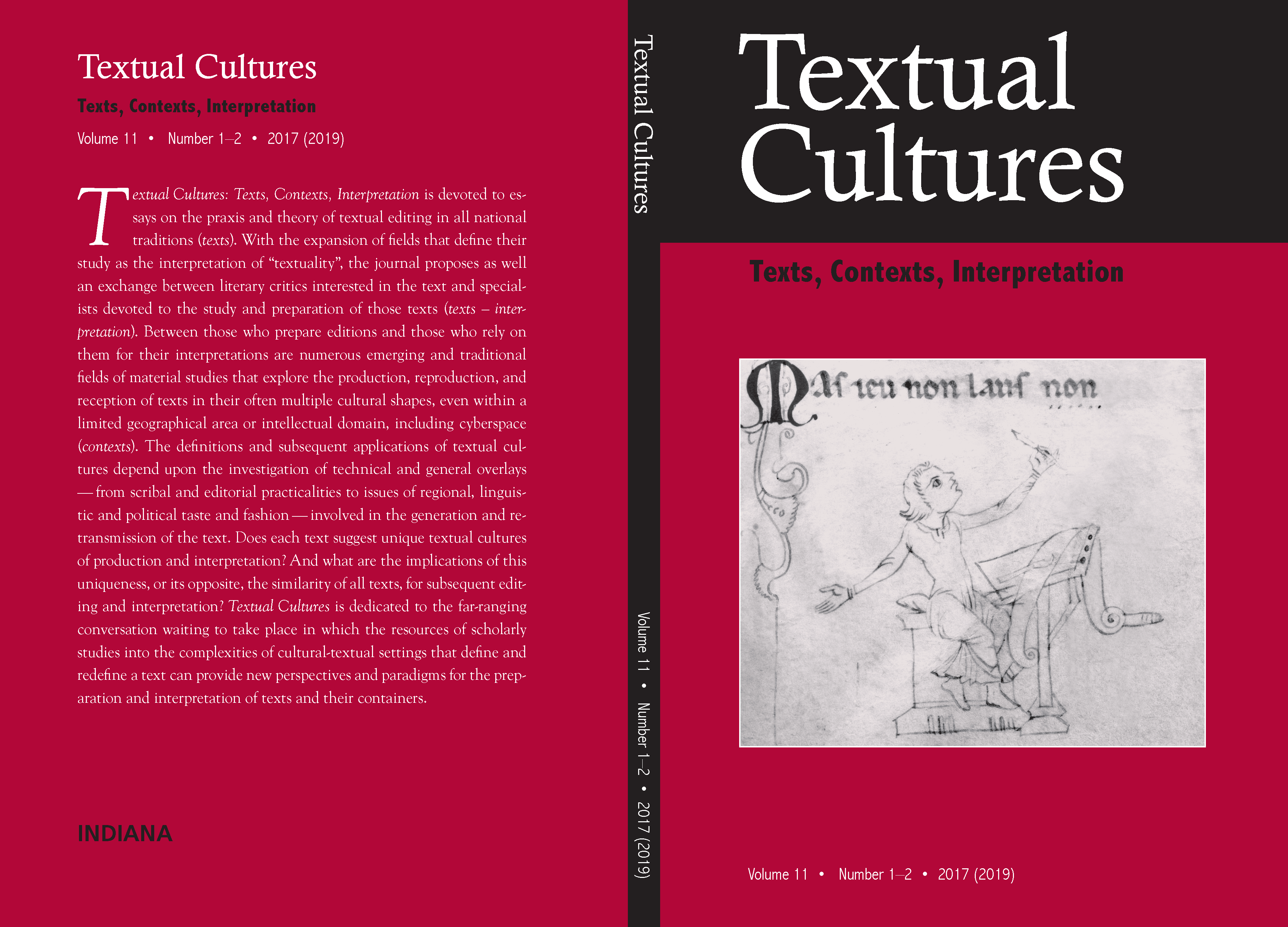How To Think About EEBO
Main Article Content
Abstract
Provides a revisionist history of the history of Early English Books Online and the TEI.
Downloads
Article Details
Authors who publish with this journal agree to the following terms:
- Authors retain copyright and grant the journal right of first publication with the work simultaneously licensed under a Creative Commons Attribution License (see:http://creativecommons.org/licenses/by/3.0/us/) that allows others to share the work with an acknowledgment of the work's authorship and initial publication in this journal.
- Authors warrant that their submission is their own original work, and that they have the right to grant the rights contained in this license. Authors also warrant that their submission does not, to the best of your knowledge, infringe upon anyone's copyright. If the submission contains material for which an author does not hold the copyright, authors warrant that they have obtained the unrestricted permission of the copyright owner to grant Indiana University the rights required by this license, and that such third-party owned material is clearly identified and acknowledged within the text or content of their submission.
- Authors are able to enter into separate, additional contractual arrangements for the non-exclusive distribution of the journal's published version of the work (e.g., post it to an institutional repository or publish it in a book), with an acknowledgment of its initial publication in this journal.
References
Baker, Nicholson. 2001. Double Fold: Libraries and the Assault on Paper. New York: Random House.
Binkley, Robert C. 1948. “New Tools for Men of Letters”. Selected Papers of Robert C. Binkley, ed. Max H. Fisch. Cambridge: Harvard University Press.
Black, Alistair, and Dave Muddiman. 2012. “The Information Society Before the Computer”. Early Information Society: Information Management in Britain before the Computer, eds. Alistair Black, Dave Muddiman, and Helen Plant. Abingdon: Ash-gate.
Bush, Vannevar. 1945. “As We May Think”. The Atlantic.
Carpenter, Kenneth. 2007. “Toward a New Cultural Design: The American Coun-cil of Learned Societies, the Social Science Research Council, and Libraries in the 1930s”. Institutions of Reading: The Social Life of Libraries in the United States, eds. Thomas Augst and Kenneth Carpenter. Amherst: University of Massachusetts Press.
Cover, Robin, Nicholas Duncan, and David T. Barnard. 1991. “The Progress of SGML (Standard Generalized Markup Language): Extracts from a Comprehensive Bibliography”. Literary & Linguistic Computing 6.3: 197–209
DeRose, Steven J., David G. Durand, Elli Mylonas, and Allen Renear. 1990. “What is a Text, Really?” Journal of Computing in Higher Education 1.2: 3 –26.
Fisch, Max H, ed. 1948. The Selected Papers of Robert C. Binkley. Cambridge: Harvard University Press.
Gadd, Ian. 2009. “The Use and Misuse of Early English Books Online”. Literature Compass 6.3: 680–92.
Gitelman, Lisa. Paper Knowledge: Toward a Media History of Documents. Durham: Duke University Press.
Goldfar b, Charles. 1990. The SGML Handbook, ed. Yuri Rubinsky. Oxford: Oxford University Press.
———. 1981. “A Generalized Approach to Document Markup”. ACM SIGPLAN Notices 16.6: 68–73.
———. 1999. “The Roots of SGML — A Personal Recollection”. Technical Communi-cation 46.1: 75 – 83.
Greene, Jody. 2005. The Trouble with Ownership: Literary Property and Authorial Lia-bility in England, 1660–1730. Philadelphia: University of Pennsylvania Press.
Jamison, Martin. 1988. “The Microcard: Fremont Rider’s Precomputer Revolution”.Libraries & Culture 23.1: 1–17.
Liu, Alan. 2012. “The State of Digital Humanities: A Report and Critique”. Arts and Humanities in Higher Education 11.1–2: 8 – 41.
Loewenstein, Joseph. 2002. The Author’s Due: Printing and the Prehistory of Copy-right. Chicago: University of Chicago Press.
Mak, Bonnie. 2014. “Archaeology of a Digitization”, Journal of the Association for Infor-mation Science and Technology 65.8: 1515–1526.
Nangle, Benjamin. 1945. “General Introduction”, in Wing, Short-Title Catalogue, v, emphasis original.
Pollard, A. W. and G. R. R ed gr av e . 1926. A Short-Title Catalogue of Books Printed in England, Scotland, & Ireland. London: The Bibliographical Society.Poole, Hilary W. 2005. “Charles Goldfarb, Inventor of SGML”. The Internet: a His-torical Encyclopedia. Santa Barbara: ABC-CLIO.
Popham, Michael. 1992. “SGML ‘92 Conference Report, by Michael Popham”. http://xml.coverpages.org/sgml92.html
Power, Eugene. 1958. “O-P Books, A Library Breakthrough”. American Documenta-tion 9.4: 273–276.Power, Eugene with Robert Anderson. 1990. Edition of One: the Autobiography of Eugene B. Power. Ann Arbor: University Microfilms International.
Renear, Allen. 2004. “Text Encoding”. A Companion to Digital Humanities, ed. Susan Schreibman, Ray Siemens, John Unsworth. Oxford: Blackwell.
Renear, Allen, Elli Mylonas, David G. Durand. 1996. “Refining Our Notion of What Text Really Is: The Problem of Overlapping Hierarchies”. Research in Human-ities Computing, ed. Nancy Ide and Susan Hockey. Oxford: Oxford University Press.
Rice, Stanley. 1978. Book Design: Text Format Models. New York: R. R. Bowker.
Rider, Fremont. 1944. The Scholar and the Future of the Research Library, A Problem and Its Solution. New York: Hadham Press.
Rose, Mark. 1993. Authors & Owners: The Invention of Copyright. Cambridge: Har-vard University Press.
Smith, Joan M. 1987. “The Standard Generalized Markup Language (SGML) for Humanities Publishing”. Literary & Linguistic Computing 2 . 3: 171–75.
Sperberg-McQueen, C. M. 1991. “Text in the Electronic Age: Textual Study and Text Encoding, with Examples from Medieval Texts”. Literary & Linguistic Comput-ing 6.1: 34–46.
———. 1992. “Trip Report: SGML ‘92, Danvers, Mass”. http://cmsmcq.com/1992/edr2.html
St. Cl a i r, William. 2004. The Reading Nation in the Romantic Period. Cambridge: Cambridge University Press.
Stevens, Rolland E. 1971. “The Microform Revolution”, Library Trends January: 379–395.
Sutherland, Kathryn and Marilyn Deegan. 2016. Transferred Illusions: Digital Technology and the Forms of Print. New York: Routledge.
Ta bor, Stephen. 2007. “ESTC and the Bibliographic Community”, Library 8.4: 367–386.
TEI Consortium, eds. 2019. Guidelines for Electronic Text Encoding and Interchange. 29th January 2019. http://www.tei-c.org/P5/.
———. 1987. “Minutes of the meeting of the temporary Steering Committee. Pisa, 12–13 December 1987”. TEI SCM01. http://www.tei-c.org/Vault/SC/scm01.txt
———. 1989. “Minutes of Advisory Board Meeting, Chicago, 18–19 Feb 89”. TEI ABM1. http://www.tei-c.org/Vault/AB/abm01.gml
